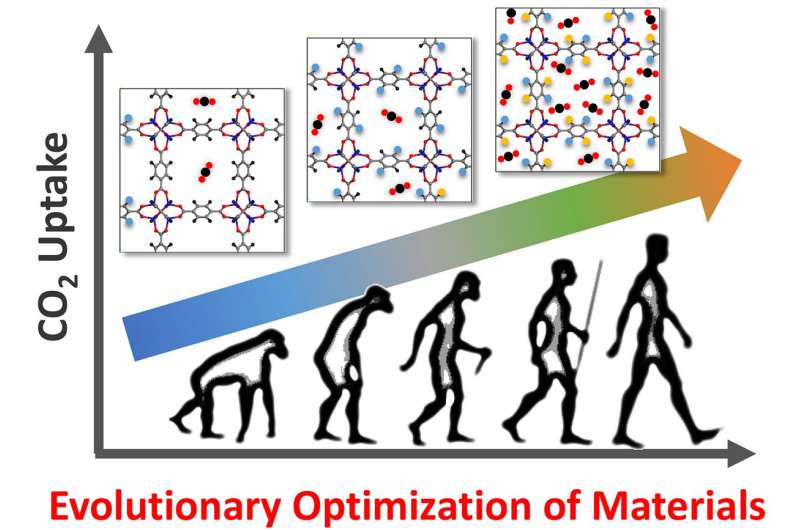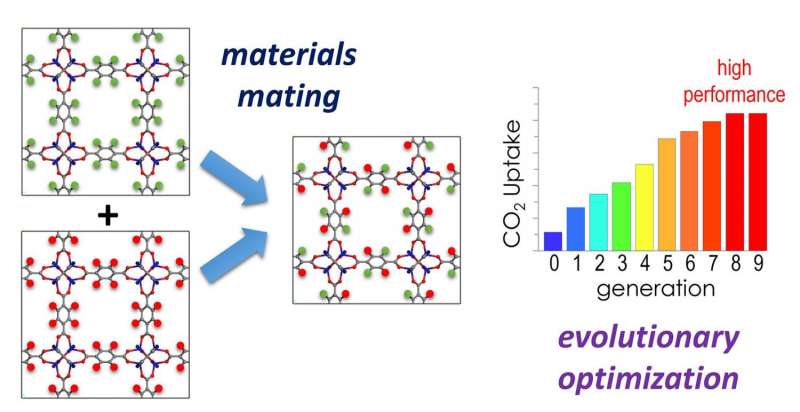November 24, 2016 report
Use of genetic algorithm helping to find the best carbon dioxide sponge

(Phys.org)—A team of researchers with the University of Ottawa has found that an algorithm used in genetic research has proven to be useful in helping to narrow down the number of possible carbon dioxide sponges, aka, metallic-organic frameworks(MOFs) for possible use in industrial applications. In their paper published in the journal Science Advances, the team describes how they used the algorithm, what it helped them find and what still needs to be done to figure out if the MOFs they isolated might actually be used some day to capture carbon dioxide from coal burning plants before it is emitted into the atmosphere.
Most scientists now agree that global warming is actually happening and that we humans have caused it. Because of that a host of scientists around the world are working on projects dedicated to reducing greenhouse gas emissions, particularly carbon dioxide. The biggest offenders, automobiles and coal fired electricity producing plants are the main focus. In this new effort, the researchers sought a way to narrow down the number of possible MOFs that could be used to grab the carbon dioxide that is released from coal when it is burned before it is released into the air and which also allows for release so that it can be sequestered.
MOFs are compounds that consist of metal ions or clusters that are coordinated with organic ligands resulting in structures that have porous features. Because of that porosity, such materials can be used like a sponge—carbon dioxide molecules, for example, can become lodged inside of them during exposure. Because of that property, scientists would like to know which of the millions of possible types of MOFs would work the best as a carbon sponge in an industrial plant. To help narrow them down, the researchers turned to an algorithm that geneticists have developed to imitate the process of natural selection over time. The researchers used it by starting with 23 "parent" MOFs that had been tested by prior researchers—each was "mated" with another MOF and the offspring judged for its suitability—the process was repeated over and over moving through a list of 1.65 million possibilities. The ideal MOF would grab a large number of carbon dioxide molecules (because of a large surface area) and release them easily when heated.
The team reports that the algorithm helped identify approximately 1,000 MOFs that were deemed exceptional, 141 of which could actually be created and tested in the lab.

More information: S. P. Collins et al. Materials design by evolutionary optimization of functional groups in metal-organic frameworks, Science Advances (2016). DOI: 10.1126/sciadv.1600954
Abstract
A genetic algorithm that efficiently optimizes a desired physical or functional property in metal-organic frameworks (MOFs) by evolving the functional groups within the pores has been developed. The approach has been used to optimize the CO2 uptake capacity of 141 experimentally characterized MOFs under conditions relevant for postcombustion CO2 capture. A total search space of 1.65 trillion structures was screened, and 1035 derivatives of 23 different parent MOFs were identified as having exceptional CO2 uptakes of >3.0 mmol/g (at 0.15 atm and 298 K). Many well-known MOF platforms were optimized, with some, such as MIL-47, having their CO2 adsorption increase by more than 400%. The structures of the high-performing MOFs are provided as potential targets for synthesis.
Journal information: Science Advances
© 2016 Phys.org




















